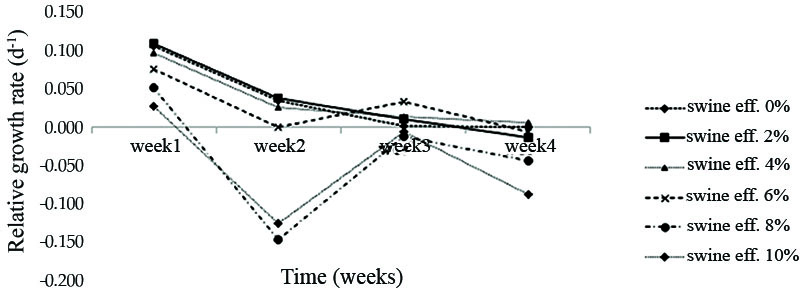Study on Growth, Nutrients Accumulation and Release from Azolla Cultured in Swine Farm Effluent
Main Article Content
Abstract
This research aims to study the accumulation and the release of nutrients from Azolla that cultured in swine wastewater effluent for using as a soil amendment. In this study, Azolla were cultivated for 1 month in anaerobic swine wastewater effluent at 0, 2, 4, 6, 8 and 10 % dilutions. The results showed that the concentration of effluent and the duration of culture affected the growth of Azolla. Azolla could be growth better in low effluent dilutions. At 2 % effluent dilution, Azolla was reported as the highest growth with dry weight at 16.46 ± 0.8 g/m2 and the relative growth rate at 0.11 d-1. The optimum period for cultivating Azolla was 2 weeks. The nutrient concentration of the cultivated Azolla of N, P and K were 3.35, 0.87 and 7.43 %, respectively. The study on nutrients release of Azolla was determined by incubation of soil mixed with Azolla. The results suggested that Azolla increased organic materials in soil and released nutrients during 7 weeks of incubation, starting from the first two weeks. In conclusion, Azolla is suitable for soil amendment development due to rapid and long- lasting nutrients release.
Article Details
References
[2] Bocchi, S. and Malgioglio, A. (2010). Azolla-anabaena as a Biofertilizer for Rice Paddy Fields in the Po Valley, a Temperate Rice Area in Northern Italy. International Journal of Agronomy. Vol. 2010, pp. 1-5. DOI: 10.1155/2010/152158
[3] Watanabe, I. and Ramirez, C. (1990). Phosphorus and Nitrogen Contents of Azolla Grown in the Philippines. Soil Science and Plant Nutrition. Vol. 36, Issue 2, pp. 319-331. DOI: 10.1080/00380768.1990.10414998
[4] Wongbung, W. (1994). Azolla and Utilization in Rice Field. Natural Agriculture Journal. Vol. 11, No. 3, pp. 44-50
[5] Klomje, P., Homhaul, W., Suwannasri, D., and Phonrit, N. (2015). Swine Wastewater Treatment Using Water fern (Azolla microphylla) in Floating Aquatic Plant Wastewater Treatment System. KKU Science Journal. Vol. 43, No. 4, pp. 698-714
[6] Tokhun, N., Boonthai Iwai, C., and Ta-oun, M. (2011). Wastewater Treatment from Piggery farm by Using Azolla microphylla. In Proceedings of the 12th Graduate Research Conference Khon Koen University. pp. 779-783
[7] APHA, AWWA and WEF. (1998). Standard Methods for the Examination of Water and Wastewaters. (20th ed). Washington, D.C.: American Public Health Publisher Inc.
[8] AOAC. (2000). Official Methods of Analysis of AOAC International. (17th ed). Maryland: Association of Analytical Communities.
[9] Soil and Plant Analysis Council. (2000). Chapter 7: Major Cation (Potassium, Calcium, Magnesium, and Sodium). In Soil Analysis Handbook of Reference Methods. pp. 109-110. New York : CRS Press.
[10] Land Development Department. (2010). Handbook of Soil Chemical Analysis Processes. Bangkok. Document No. OSD-03
[11] Pollution Control Department. (2005). Water Quality Standard. Access (6 August 2018). Available (https://www.pcd.go.th/info_serv/reg_std_water.html)
[12] Tylova-Munzarova, E., Lorenzen, B., Brix, H., and Votrubova, O. (2005). The Effects of NH4+ and NO3- on Growth, Resource Allocation and Nitrogen Uptake Kinetics of Phragmites australis and Glyceria maxima. Aquatic Botany. Vol. 81, pp. 326-342. DOI:10.1016/j.aquabot.2005.01.006
[13] Jampeetong, A., Sripakdee, T., Khamphaya, T., and Chairuangsri, S. (2016). The Effects of Nitrogen as NO3- and NH4+ on the Growth and Symbiont (Anabaena azollae) of Azolla pinnata R. Brown. Chiang Mai University Journal of Natural Sciences. Vol. 15, No. 1, pp. 11-20. DOI: 10.12982/CMUJNS.2016.0002
[14] Singh, P. K., Sing, D. P., and Sing, R. P. (1992). Growth, Acetylene Reduction Activity, Nitrate Uptake and Nitrate Reductase Activity of Azolla caroliniana and Azolla pinnata at Varying Nitrate Levels. Biochemie and Physiologie der Pflanzen. Vol. 188, Issue 2, pp. 121-127. DOI: 10.1016/S0015-3796(11)80019-3
[15] Forni, C., Chen, J., Tancioni, L., and Caiola, M. G. (2001). Evaluation of the Fern azolla for Growth, Nitrogen and Phosphorus Removal from Wastewater. Water Research. Vol. 35, No. 6, pp. 1592-1598
[16] Costa, M. L., Santos, M. C., and Carrapiç, F. (1999). Biomass Characterization of Azolla filiculoides Grown in Natural Ecosystems and Wastewater. Hydrobiologia. Vol. 415, pp. 323-327. DOI: 10.1023/A:1003824426183
[17] Prakobmee, A., Isarangkool, Na Ayutthaya S., and Techawongstien, S. (2014). Effect of Leaves Age and Leaves Position on Macronutrients in Leaves of Rubber Tree Clone RRIM 600. Khon Kaen Agriculture Journal. Vol. 42, Supp l, pp. 180-185
[18] Maejima, K., Kitoh, S., Uheda, E., and Shiom, N. (2001). Response of 19 Azolla Strains to a High Concentration of Ammonium Ions. Plant and Soil. Vol. 234, Issue 2, pp. 247-252. DOI: 10.1023/A:1017912613526
[19] Department of Agriculture announced in the organic fertilizer criteria B. E. 2557. (2014, 12, February). Government Gazette. Suppl. 29, Vol. 131, pp.4
[20] Treeamnuk, T. (2014). A Study on Appropriate Approaches for Integrated Management of Organic Fertilizer Production. Research Report. Nakhorn Ratchasima: Suranaree University of Technology

